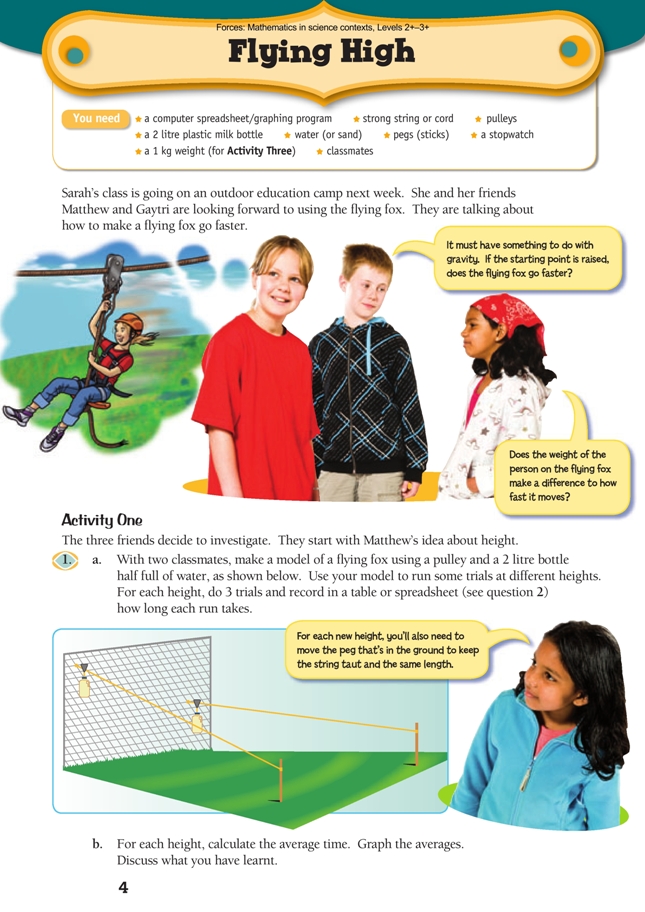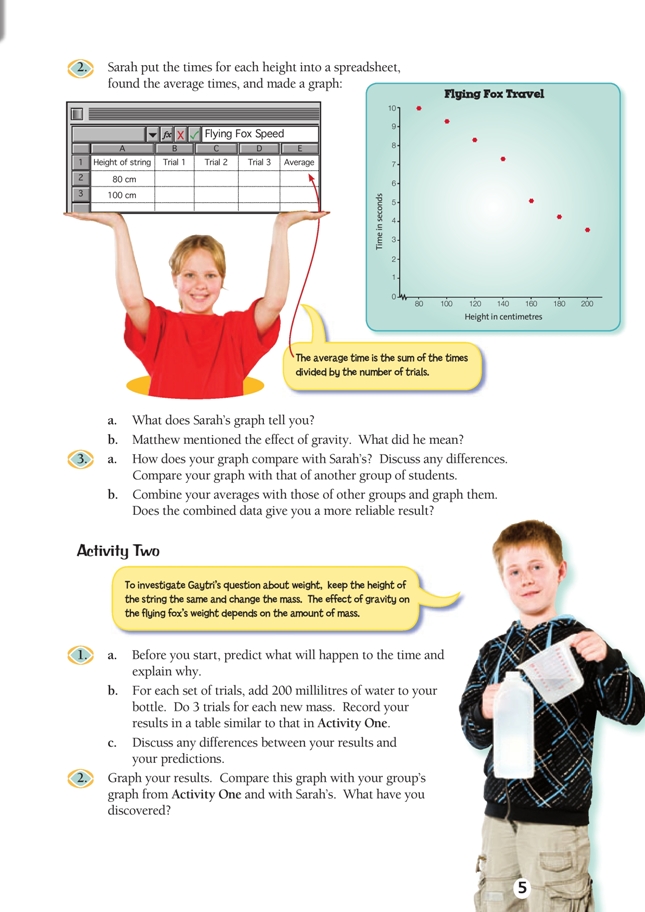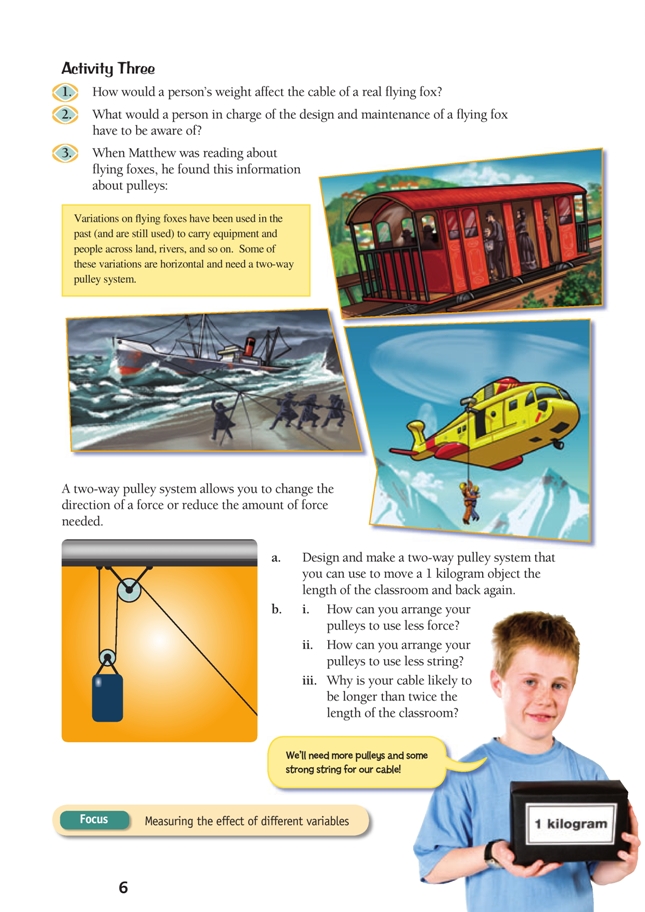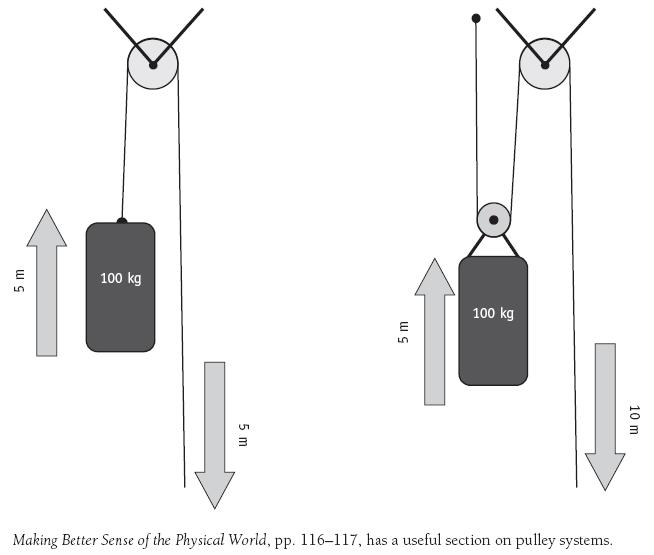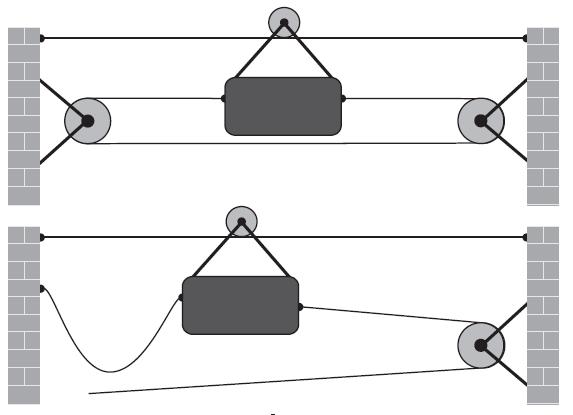This is a level (2+ to 3+) mathematics in science contexts activity from the Figure It Out series.
A PDF of the student activity is included.
Click on the image to enlarge it. Click again to close. Download PDF (1086 KB)
Students will:
- measure mass, angle, time, and speed
- find the relationships between mass, speed, and angle for a flying fox
- record data in tables and use graphical representations to interpret the results
- calculate average speed by dividing the distance travelled by the time taken.
Students should discover that:
- acceleration is not proportional to mass. Larger masses are pulled with more force, but the acceleration is the same.
water (or sand)
pegs (sticks)
a stopwatch
a 1 kg weight (for Activity Three)
pulleys
strong string or cord
a computer spreadsheet/graphing program
classmates
FIO, Forces, Levels 2+-3+, Flying High, pages 4 - 6
Activity One
Preparation and points to note
A flying fox is a very simple device, consisting of a pulley and a cable strung between two points. It can be used to carry a person in a harness. A flying fox relies on gravity* to move the pulley (and the person) from one point to the other. To work, one end of the flying fox must be higher than the other.
For the modelling, make sure there is enough uninterrupted space to stretch the lines without crossing. It may be best to do this investigation outside because it uses water (or sand) and the students also need to find suitable anchor points. Possible anchor points could be a wire fence, a fixed ladder, or objects in an adventure playground. Make sure that the pulleys are attached in such a way that they run smoothly. The students may need some practice using a stopwatch to time the passage of the milk bottle. (A 1 litre milk bottle full of water has a 1 kg mass.)
In case the students get over-excited about running their flying fox, establish or reinforce appropriate norms for working in new environments or with potentially dangerous equipment. Also consider the needs of individual students when grouping.
Consider setting up multiple lines at different angles in advance and have groups of students rotate around the circuit to gather their data. This avoids students having to repeat investigations to get more reliable data and enables discussion about validity because groups can compare and combine their data for the same investigation.
The graph is best done using a spreadsheet if the students have access to computers.
One aspect of the key competency managing self is that students learn to accept that they may feel confused while they gain new understanding. You may choose to emphasise this here.
With multiple trials at different heights, your students will be asked to record a lot of data. Encourage them to think aloud about how they might record the information, for example, “Hmm … How big will my table be? If I have 3 trials, that means 3, no, 5 columns because I need to record height and average as well. How many rows?”
Rather than trying to run a plastic milk bottle along the string, use a pulley to attach the milk bottle to the wire. (You can buy pulleys at any hardware store.) The milk bottle can be attached to the pulley with string through the handle.
The students need to take the height of the milk bottle into consideration at the lower end of the flying fox so that it doesn’t hit the ground or collide with the peg. Collision can be avoided by having one student act as “catcher”.
Note that if the peg in the ground remains the same horizontal distance from the anchor point (for example, a fence) each time one end of the string is raised, the length of the string will need to be increased. This will distort measurements and conclusions (hence the instruction in the students’ book).
Points of entry: Mathematics
In this activity, students measure time and speed, not distance. However, it is useful to ask your students to explain how speed relates to both distance and time. Ask What does it mean to say someone is faster than someone else?
Prompt the students to think about appropriate units. Using either informal units or a linear scale, they could measure the height of each attachment point. They could also measure mass, duration, length, and angle, selecting an appropriate measurement tool and units. While accuracy is desirable, the identification of patterns or relationships is more important.
While the height increment does not need to be a fi xed value, it may be best to encourage the students to be systematic and increase the height each time by, say, 10 or 20 centimetres. Increasing height is the same as increasing angle, so encourage the students to also frame their thoughts in terms of slope and how slope increases. For example: What if you increased the height of both the start and fi nish points? What if you moved the start and finish further apart or closer together? Slope is the difference in height divided by the difference in length and is measured as a rate or angle. Note: The graph on page 5 of the students’ book says “height”. This could be taken as either the height from the bottom of the fence (as long as the height of the string on the peg at the lower end of the flying fox stays the same, as in the diagram) or the difference between start and finish heights. Ask your students to explain why the height of the string at the bottom of the flying fox is important when talking about how far the flying fox travels vertically.
Points of entry: Science
Activate the students’ prior knowledge of height, angle, and speed. They will probably know that the higher a ramp is, the faster a bicycle will go down it. Introduce the idea of quantifying “how much faster” in order to make accurate predictions. Ask Will a flying fox that is twice as steep go twice as fast?
Refer to the scientific inquiry method (see page 5). Frame the investigation using scientific language: What makes a trial a fair trial? Data outliers are useful for discussion and can prompt students to consider methods as well as results. Different trials will probably go at different speeds. Make sure that the students are comfortable with the idea of variation, error, and chance factors (for example, the wind).
Use natural opportunities to introduce or reinforce vocabulary such as hypothesis, prediction, mass, and force.
Make sure that the students relate their results back to the conjectures made by Matthew and Gaytri about how to make a flying fox go faster.
Ask the students to apply their results to other contexts, for example, running down a hill.
Answers
Activity One
1. a.–b. Practical activity and discussion. Make sure that you are recording your data in an organised way. Averages and graphs will vary.
2. a. The graph shows the height of the string at each trial and how long each run took. From the results shown on this graph, you can see that the higher the height at the top end (the bottom height stays constant), the quicker the flying fox travels.
b. Gravity is a force pulling the flying fox towards the ground. From the trials, it looks like speed does have something to do with gravity – the further an object falls, the faster it goes! Gravity is always acting, so a person on a flying fox would experience the force the whole time they were falling. Forces change motion: either they speed the flying fox up or slow it down. In this case, as the
flying fox falls, it speeds up. (If you were on an “extreme flying fox”, released at a height of 175 m, you would reach a speed of 160 km/h.)
3. a. Your graph should look similar to Sarah’s and clearly show that the steeper the angle, the faster the flying fox goes.
b. The more data you have on the same subject and experiment, the more reliable it will be and the more accurate your conclusions. Combining the data will “smooth” the graph and cancel out any unusual results (outliers).
Activity Two
Preparation and points to note
Let the students experiment with trial runs to ensure that their flying fox runs freely. Sand or rice could be used (instead of water) to fi ll the bottles, but you will need measuring scales. The advantages of water are that 1 litre weighs 1 kg at normal temperatures and it’s readily available.
Consider having objects of different mass on hand to help with misconceptions about gravity, mass, and falling speed, for example, a bowling ball and a tennis ball. (See the answers and support material for page 1, Introducing Forces.)
Many people would predict that a heavier fl ying fox will run faster. However, the acceleration of gravity is constant, so all objects fall at the same rate. You can demonstrate this to your students by simultaneously dropping a heavy and a light object and asking them which one landed first. If there is no air resistance, they should both land on the ground at the same time. (However, the force of gravity is stronger on a heavy object than on a light one. To speed them both up by the same amount, gravity pulls harder on a heavy object – to get it moving – than on a light one.)
In the activity, make sure that the string doesn’t start to sag because this will distort the data.
Points of entry: Mathematics
Check for experimental error: are the students “looking” for a particular result and throwing out data that doesn’t fit their expectations?
Ensure that the students make the connection between the volume of water (1 litre) and the mass (1 kg).
Points of entry: Science
Challenge the students’ misconceptions: If you drop a cricket ball and a tennis ball, which lands first? If possible, have them try this and discuss what happened.
Make sure that the students discuss their predictions before they try the experiment. You can relate this back to hypothesis and the scientific inquiry method (see page 5).
Encourage the students to discuss their results with other groups. This will reinforce the key competency thinking by providing opportunities for students to learn from their mistakes, improve their processes, and refine their conclusions.
Question what forces may be acting on the milk bottles (other than gravity) and how these may affect their speed.
Make sure that the students relate their results back to their predictions and that they try to develop reasons why their predictions were right or wrong.
Ask the students to apply their results to other contexts, for example, vehicles of different sizes going down a hill.
If possible, ensure that the whole class comes to a consensus on why height affects the speed but mass doesn’t. For example, “Gravity pulls everything down. The higher the angle, the closer it gets to straight down, so gravity pulls it better. Gravity accelerates all masses at the same rate.” Make sure that the students are not confusing force with acceleration – gravity accelerates all mass at the same rate, but the force of gravity is greater on larger masses, which is why they feel heavier.
Note: Some students might see the trend part-way through the experiment and wonder why they should bother continuing. Discuss how some effects might be non-linear, for example, the experiment might follow one pattern at first, and then the pattern changes. Confirming that a result is true throughout a range is also important.
Answers
Activity Two
1. a. Predictions and explanations will vary.
b. Practical activity
c. Hopefully, you’ll see that the times are about the same no matter what mass you have in your flying fox. There may be some variation, but in general, adding more mass shouldn’t speed it up.
2. The graph will be much more of a flat line than the height compared with time graph in Activity One. Changing the mass should not change the speed.
Activity Three
Preparation
For question 3, the students will need more (and possibly stronger) string (or rope) and pulleys. You may wish to make groups larger to minimise materials. A 1 kilogram weight could simply be 1 litre of water.
Points of entry: Mathematics
Cable sagging will give non-linear behaviour, in other words, the fl ying fox will speed up or slow down at different points because of the sag. Challenge the students to describe the behaviour in different parts of the cable. For example, they might say, “In the beginning, it’s really steep, but then it sags and the weight goes slower as it travels down the cable because the sag makes the cable path less steep.”
Encourage the students to frame their questions in a mathematically testable (quantifi able) way. For example, when they are investigating pulley systems, ask How will you measure force? Such critical thinking is an important aspect of the key competency thinking.
A calibrated spring or a scale attached to one end of the pulley cable will give a good reading of the force exerted.
Points of entry: Science
Other variables that could be investigated could be changing the mass of the object being moved, the tension in the cable, or exploring aerodynamics using different shapes. The Making Better Sense books have an investigation planner at the start that students could use.
A two-way pulley system allows the user to swap force for distance. The pulleys make it easier to lift a load but increase the distance the rope travels by the same factor. To lift a 100 kg weight 5 m with a single pulley, the free end of the rope travels 5 m. If you use 2 pulleys, the same load will feel like 50 kg, but the free end of the rope will travel 10 m (see diagram). (100 x 5 = 50 x 10)
Answers
Activity Three
1. A person’s weight (which is being pulled on by gravity) can have a big effect on a fl ying fox. A heavy weight can cause the cable to sag a lot, which will reduce the effect of gravity; that is, the cable will become more horizontal over the second half of the fl ying fox’s travel. (However, on a very strong cable with no sag and no other factors such as strong wind, the difference will be minimal. A heavier person should reach the end about the same time as a lighter person because
gravity pulls harder to get the heavier person moving at the same speed as the lighter person.)
2. A flying fox designer will have to be aware of the mass of the users, the length of the run, the tension on the cable, how often it’s used (how much wear and tear), and how much maintenance it will need.
3. a. Practical activity
b. i. You can arrange your pulleys to use less force by combining two or more pulleys together, for example, loop the string or cable around a pulley attached to the load and around another pulley attached to the wall, as shown in the diagram below.
ii. The fewer pulleys you use, the less string you need because each pulley adds an extra loop of string or cable. The simplest arrangement is a single pulley to support the flying fox and a horizontal
cable.
iii. The cable is likely to be longer than twice the length of the classroom because you’ll need at least one full loop of the classroom for a two-way pulley that can pull the load all the way to one end and then pull it all the way back, plus some extra cable to go around each of the pulleys.
